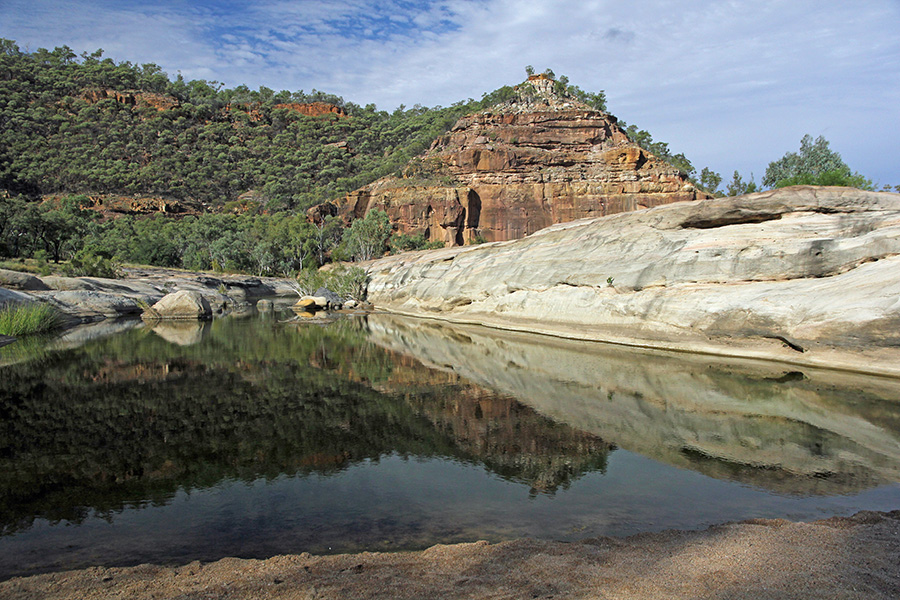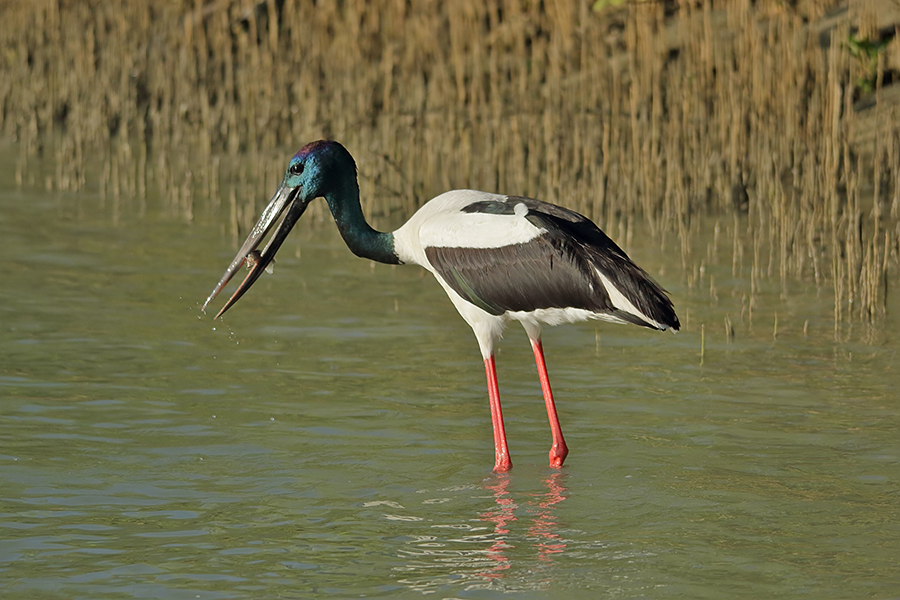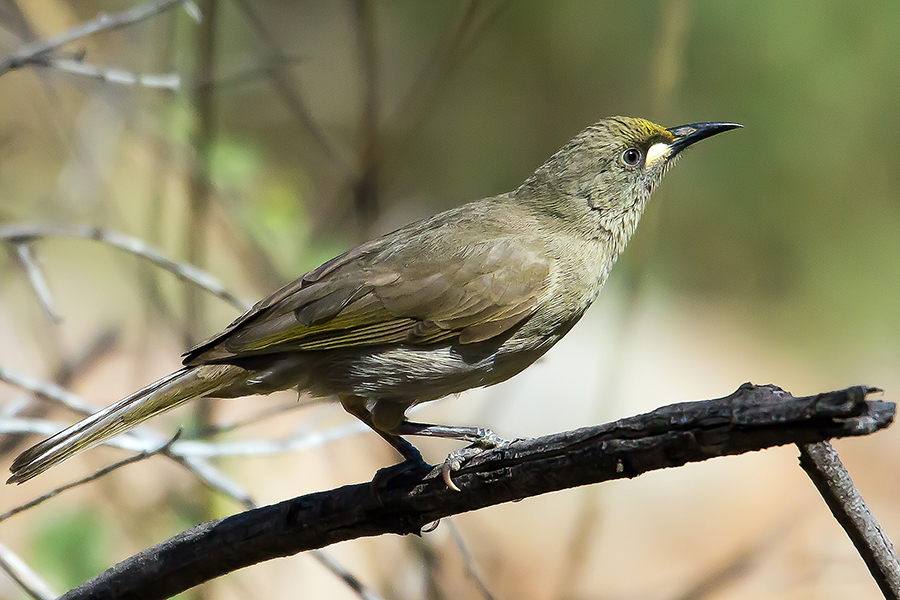Report submitted by Gary King
My recent trips would duplicate reports already on the website and submitted by Doug Castle and Tim Van Leeuwin so I am submitting a report from a different region of Australia.
This trip focused on the birds of the Gulf of Carpentaria, the savannah woodlands of the region, Lawn Hill Station and Boodjamulla NP. The birds reported are the species I photographed and not necessarily all the species seen.
Porcupine Gorge NP (north of Hughenden) – There is a good National Parks camping area which is easily accessed and a nice walk down into and along the gorge to a huge pyramid shaped rock. The only bird of note was a Pale-headed Rosella.

Undarra – Heading north to Mt Surprise and then in to Undarra to see the fascinating Lava Tubes. The only bird I photographed was a Noisy Friarbird.
Forsayth – Heading west towards Cobbold Gorge we stopped at Forsayth Hotel for a coffee and in a large Callistemon in front of the hotel I saw and photographed Banded and Brown Honeyeaters.
Cobbold Gorge – This place is worth a visit as the gorge is quite young and very narrow. As it is on private property there is a fee to go on a tour of the gorge which includes a boat trip. In places you can touch both sides of the gorge at once. The following species were photographed: Restless Flycatcher, Squatter Pigeon, Red-winged Parrot, Hoary-headed Grebe and White-bellied Cuckoo-shrike.
Flat Creek Station – This is north of Cobbold Gorge and is a farm-stay aimed at fossickers and bird-watchers. The owners breed Gouldian Finches for release into the wild. We saw them in the aviary but not in the wild. Birds seen and photographed included Rufous-throated Honeyeater, Black-throated Finch, Plumed Whistling Ducks, Little Friarbird, Squatter Pigeon and Blue-winged Kookaburra.
Georgetown - It was then on to Georgetown for shopping and an overnight stay.
Cumberland Chimney – This is just west of Georgetown and you can camp here. There is a large dam left over from the mining days. Species photographed included Masked Lapwing, Green Pygmy Goose, Magpie Goose, Red-backed Fairywren, Peaceful Dove, Red-tailed Black Cockatoo and Pied Butcherbird. We then continued west through Croydon to Normanton and on to Karumba.
Normanton – Just north of Normanton there is a wetland where the following species were photographed from the road: Sarus Crane, Brolga and Eastern Great Egret.
Karumba – At Karumba boat tours are run that enable you to see and/or photograph the mangrove species. Karumba is also a great place to buy fresh fish for dinner. We saw and photographed Red-headed Honeyeater, Mangrove Robin, Mangrove Gerygone, White-breasted Whistler, Mangrove Golden Whistler, White-breasted Sea Eagle, Black-necked Stork, Royal Spoonbill, Yellow-billed Spoonbill, Radjah Shelduck, Glossy Ibis, Rainbow Bee-eater, Yellow Honeyeater, Yellow White-eye, Yellow-tinted Honeyeater, White-winged Triller, Yellow Oriole, Double-barred Finch. Brolga and Sarus Crane.

We then travelled back to Normanton and headed west to Burketown before heading south west via Leichardt Falls and Gregory Downs to Lawn Hill Station.
Lawn Hill Station/Boodjamulla NP – You can camp at either Lawn Hill (Adel’s Grove) or the National Park. It is truly a beautiful place with great walks and canoeing or boating up the gorge. Birds photographed included: Purple-crowned Fairywren, Northern Fantail, Black-bellied Crimson Finch, Restless Flycatcher, Buff-sided Robin, Sandstone Shrike-thrush, White-gaped Honeyeater, Great Bowerbird and Red-tailed Kingfisher. It is also worth a side-trip to the Riversleigh World Heritage Area, one of the richest fossil deposits in the world.

After a wonderful 5 days we headed north though Lawn Hill Station, seeing cattle mustering by helicopter along the way to Hell’s Gate Roadhouse to overnight.
Hell’s Gate – Birds photographed were Yellow-tinted Honeyeater and Rufous-throated Honeyeater.
It is 340km from Hell’s Gate to Borroloola. About half way, not long after crossing the Northern Territory border, the axle broke on the camper-trailer. We then had to wait for someone to come along with a satellite phone. This did not take too long but it was a 5 hour wait for the tow truck to arrive and then a week in Borroloola while parts came from Darwin and repairs were carried out.
Borroloola – Birds photographed were Red-tailed Black Cockatoo, Black-bellied Crimson Finch and Lemon-bellied Flycatcher.
Between Borroloola and Cape Crawford is the Caranbirini Conservation Reserve which is worth a visit, It has a two nice walks and a “Lost City” which is quite spectacular. We spent time looking for the Carpentarian Grasswren without success.
Caranbirini Conservation Reserve – Birds photographed were Long-tailed Finch, Bar-breasted Honeyeater, White-faced Heron and Whistling Kite.
Mt Isa – On the way home we stopped at Mt Isa and went out to Lake Moondarah where I photographed White-browed Woodswallow, Spinifex Bird, Whistling Kite and Varied Lorikeet.
Apart from the camper-trailer incident it was a great trip and I believe I would see more species if we did the trip again. I would particularly like to go back and search for the various species of Grasswren that inhabit western Queensland.